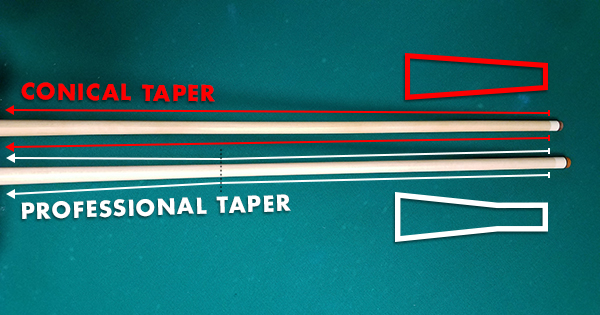
ASK THE MASTER: "Does the taper of a cue shaft make any difference in the cue's performance?"
In a word, YES. While I am definitely not an expert on this subject, I can give some general information. Beyond that lies a murky world of cue-making secrets. Top custom cue builders typically develop their own "signature" tapers. There are many claims about the "quality of the hit" with various tapers. Arguments about taper have been underway for decades. Visit a cuemaker forum and read to your heart's content.
The most important aspect of a shaft from a performance perspective is it's squirtiness (aka cueball deflection). When using sidespin, the cueball, because it's hit a little on the side, veers a few degrees off the stick line (left spin squirts the cueball to the right). This is an angle change at the moment of tip-ball impact. Roughly, the shaft deflects (bends) off the side of the ball, while the ball squirts in the other direction. This means you have to adjust your aim accordingly.
This video shows EVERYTHING you need to know about Cue Ball Deflection:
As players, we care about where the cueball is going, not what the shaft does. All shafts cause squirt. Less squirt means less aim adjustment, so we argue that "low squirt" shafts are better for our purposes.
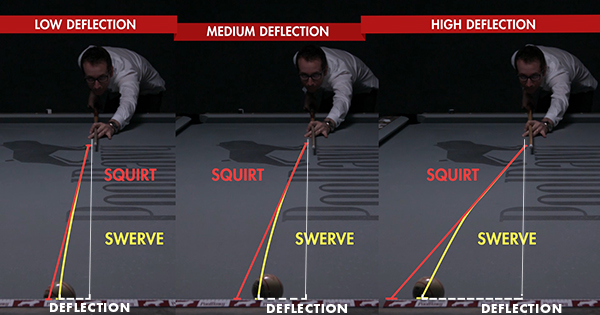
One important fact here is that the big secret to reducing squirt is "shaft endmass." In other words, how much weight is there at the tip end of the shaft? Less mass, less squirt, less aim adjustment. Mass is reduced in many ways. Examples include skinnier shaft diameter, shorter ferrule (plastic weighs more than wood), lighter ferrule material, wooden ferrules, pinhole drilling of the ferrule, hollowing out of the tip end of the shaft, etc.
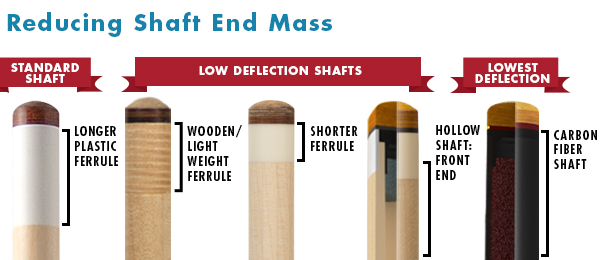
That said, how does taper relate to squirt? The most obvious aspect is shaft diameter. Since thinner shafts weigh less, there is less mass out at the tip end, and therefore less squirt. This is why the various skinny, low squirt shafts such as the Predator Z series, the OB-2, the McDermott I-3 and so on actually do squirt less. (Note: There are trade-offs, so these shafts are definitely not for everyone.)
In general, we have two types of taper: conical and pro. Conical taper means the shaft (and maybe the whole cue – think "house cues") smoothly tapers from the fat end to the skinny end, like a cone. Pro taper means the shaft is one constant diameter from the tip back maybe 12"-14" or so, and then begins to cone out toward the joint. This allows the player to have a bridge that doesn't interfere with the stroke or the tip position at impact. With an open bridge, a conical taper shaft will cause the tip to rise a bit as it moves forward and thicker portions of the shaft cross the hand. For the same reason, a snug closed bridge can impede the conical shaft as the thickness changes throughout the stroke.
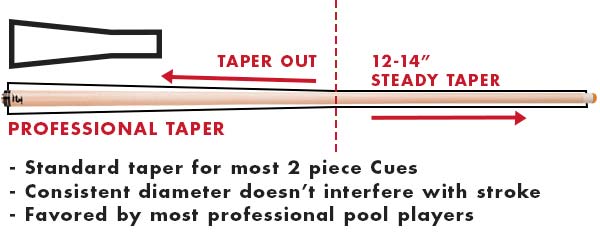
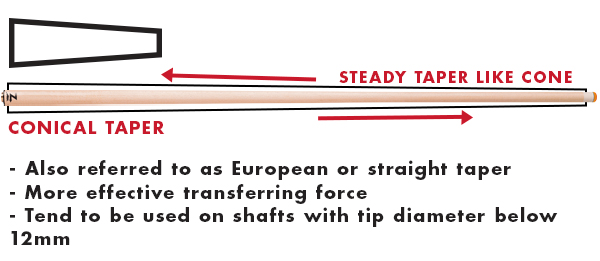
Generally speaking, house cues and billiard cues are conical while most two-piece pool cues and after-market pool shafts are some variation of pro taper. Some billiard players refer to their taper as direct or straight taper. Many believe that a fast taper (one that expands more quickly from the tip) is more effective in transferring force to the cueball. Pro taper is favored by most professional pool players, hence the name.
 Frank Says: "Here at PoolDawg, we can swap out shafts on most of our Pool Cues. Want to get a specific butt with a different shaft? Give us a call (866-843-3294) and we'll do our best to make that happen. We only charge extra if there is a difference between the shafts prices!"
Frank Says: "Here at PoolDawg, we can swap out shafts on most of our Pool Cues. Want to get a specific butt with a different shaft? Give us a call (866-843-3294) and we'll do our best to make that happen. We only charge extra if there is a difference between the shafts prices!"
Back to pool cues, top custom cuemakers experiment with subtle variations in taper. How far from the tip does the shaft diameter remain constant, and how fast or slow does it expand out from there. Shaft diameter matters, wood quality, grain, and density matter. Some shaft manufacturers build 10-piece shafts to "average out" the vagaries of organic, grained material, so the shaft bends the same in all directions. The new Jacoby Edge Hybrid shafts are built with 64 pieces! Cuemakers evolve their shaft performance technology to find a successful market edge.
Popular Pro Taper Shafts





Popular Conical Taper Shafts





Bottom line: There are many choices out there. When possible, try as many different shafts as you can. See what feels good in your hand, what performs in a way you feel good about, what gives you confidence. Different tapers can affect the way the shock of the tip-ball impact feels in your hand. This feedback can be valuable. As you become a better player, your ability to perceive differences in equipment expands. But bear in mind that a lot of what you feel is actually the tip. If you can't feel a difference, that's okay. Get a shaft that inspires confidence. And be open to change. Your current happy shaft may not be your best answer later in your pool career. Try stuff. In this most precise sport, tiny improvements in equipment and confidence can be huge.
< Back to Buying GuideChoosing a Pool Cue Tip >